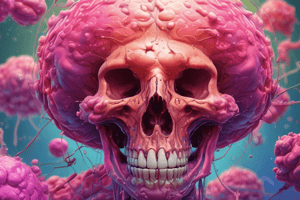Podcast
Questions and Answers
What is the main difference between benign and malignant tumors?
What is the main difference between benign and malignant tumors?
- Malignant tumors are non-cancerous.
- Malignant tumors are always harmless.
- Benign tumors are confined to their original location. (correct)
- Benign tumors spread throughout the body.
Which of the following statements about carcinomas is correct?
Which of the following statements about carcinomas is correct?
- They arise from blood-forming cells.
- They are malignancies of epithelial cells. (correct)
- They are solid tumors of connective tissues.
- They arise from precursors of red blood cells.
What makes malignant tumors resistant to localized treatment?
What makes malignant tumors resistant to localized treatment?
- Their ability to metastasize and invade other tissues. (correct)
- Their ability to remain confined in one location.
- Their slow growth rate.
- Their non-cancerous nature.
Which type of cancer arises from cells of the immune system?
Which type of cancer arises from cells of the immune system?
What is the main cause of unregulated cell proliferation leading to the development of cancer cells?
What is the main cause of unregulated cell proliferation leading to the development of cancer cells?
Which type of cancer originates from fibroblasts?
Which type of cancer originates from fibroblasts?
Flashcards are hidden until you start studying
Study Notes
Tumors are abnormal growths of cells in the body. They can be benign or malignant. Benign tumors are non-cancerous and usually remain confined to their original location, while malignant tumors are cancerous and have the ability to invade surrounding normal tissues and spread throughout the body. Malignant tumors are also known as cancers, and they are the most dangerous type of tumor as they can metastasize to other parts of the body, making them resistant to localized treatment.
There are over a hundred different types of cancer, which can vary in their behavior and response to treatment. The most common types of cancer include carcinomas, sarcomas, and leukemias or lymphomas. Carcinomas are malignancies of epithelial cells, while sarcomas are solid tumors of connective tissues, such as muscle, bone, cartilage, and fibrous tissue. Leukemias and lymphomas arise from the blood-forming cells and from cells of the immune system, respectively.
Tumors are further classified according to the tissue of origin and the type of cell involved. For example, fibrosarcomas arise from fibroblasts, and erythroid leukemias form from precursors of erythrocytes (red blood cells). The development of cancer cells involves the unregulated proliferation of cells, which may be caused by genetic mutations, environmental factors, or a combination of both.
Cancer cells differ from normal cells in several ways, such as proliferation in the absence of growth signals, ignoring signals that tell cells to stop dividing or die, and the ability to invade and spread to other parts of the body. Cancerous tumors can cause a range of symptoms, depending on their location and size, and they can impact brain function if they grow large enough to press on surrounding tissues.
Diagnosis and treatment of cancer depend on the type and stage of the cancer. Treatment options may include surgery, radiation therapy, chemotherapy, immunotherapy, or a combination of these methods. Research is ongoing to develop new treatments and to improve existing ones, with a focus on personalized medicine and precision oncology.
Studying That Suits You
Use AI to generate personalized quizzes and flashcards to suit your learning preferences.




